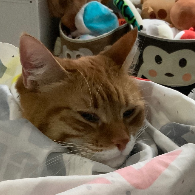Surely if you measured their sound they would have a pitch technically…
They do have a pitch, however because it is percussive as opposed to sustained, we don’t register the pitch as easily. Many will also purposely obfuscate the pitch, such as cymbals, they don’t hold a tone, but rather multiple tones at once, making a washing sound and working for any key. If you ever look at a cymbal you will see the rings and divots around the cymbal, because if they weren’t there it would ring like a bell which definitely has a pitch.
As for the drums themselves they definitely do a have a pitch and it is common for to tune them in fifths, or octaves. Think of a drumline, those drums all have pitches and tones, they also function identically to a traditional drum kit. You can very similarly to the cymbals obfuscate this tone by doing an offset tuning so your drum head resonates unevenly across the head creating multiple tonalities at once.
You can achieve this by being lazy and not tuning.
I’m a professional sound engineer and ex-professional drummer BTW.
Glad to have all you audio people and so many musicians on Lemmy :) Really getting interested in psychoacoustics for various applications lately so its been awesome :)
As an audiophile who just joined lemmy, any recommended Fediverses? :D (and am I using the term right?)
If you don’t already play with Ableton Live I highly recommend it. It’s got tons of signal-altering filters that you can chain together into pipelines and it’s great for developing an intuitive understanding of the connections between signal, waveform, sound, and perception.
Its not that they don’t have pitch, per se, it’s that the nature of the sound they produce makes the concept of “pitch” kind of meaningless.
Except for a pure sine wave, every tone is going to have multiple harmonics over the fundamental which is what actually gives an instrument, even the human voice, its timbre.
Percussion instruments like cymbals and the snare drum create broad-spectrum noise. There’s essentially so many frequencies that it’s difficult for our brains to nail it down the fundamental pitch. It’s also what helps us hear them over the rest of the ensemble.
Drums in general produce very short pulses of sound, which also makes it harder for the brain to tell what pitch it is. In harmonic analysis, any very short sound is actually broad-spectrum because it takes a ton of harmonics to produce a single sharp spike with rapid decay.
I highly recommend downloading a spectrum analyzer app on your phone to get an intuition for this. If you’re on Android, I recommend Spectroid.
Just run it and watch the screen while you make different sounds, approach various sound sources, play music, or just talk or sing. If you can whistle, that also produces an interesting result. You can actually see the frequency of the power grid in the harmonics produced by electric motors and transformer coils which is personally really fucking cool.
Op as others has commented already, percussion instruments certainly do have a pitch. For a very obvious example of a well known tune, check this video from 5 minutes 30 seconds of Phil Collins performing in the air tonight. It’s very obvious that he’s got his drums tuned so that he can play a melody.
My uneducated guess: I know drummers do tune their drums to get desired sound and tone. Also, maybe due to the quick short attack of a percussive sound, most dissonance isn’t really an issue.
Unpitched percussion instruments do have a pitch. Basically like everything else other than a sine wave generator, their sound is complex.
If you look at the fourier transform view of the signal, you’ll see a peak. Generally speaking that peak is the tone the thing makes.
This is why one recommended step in something like Ableton Live is to put a shaping filter on the drums, and then tweak the peak of that filter up and down until the drums either match or complement the tones of the notes.
@cheese_greater@lemmy.world percussion have a pitch. I don’t know about drums, but cymbals pitch is super high, so I guess it is not easy for our brains to translate into a note, so no disonance
Interesting point about cymbals :)
Haha, why’d you page me?
That’s how replies are made from mastodon afaik.
Gotcha
deleted by creator



